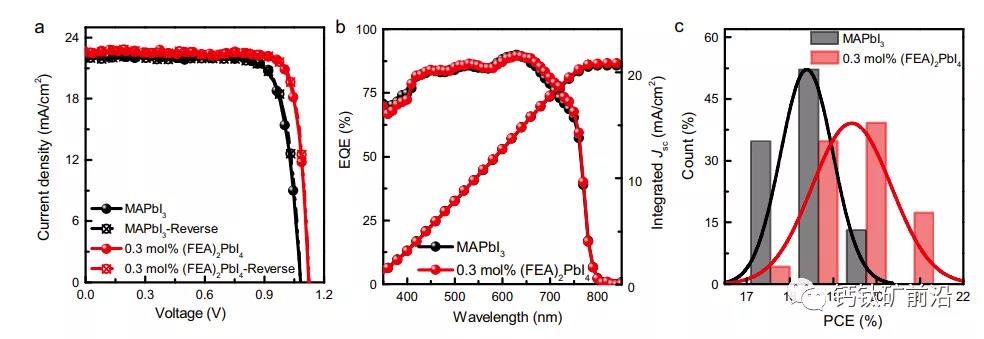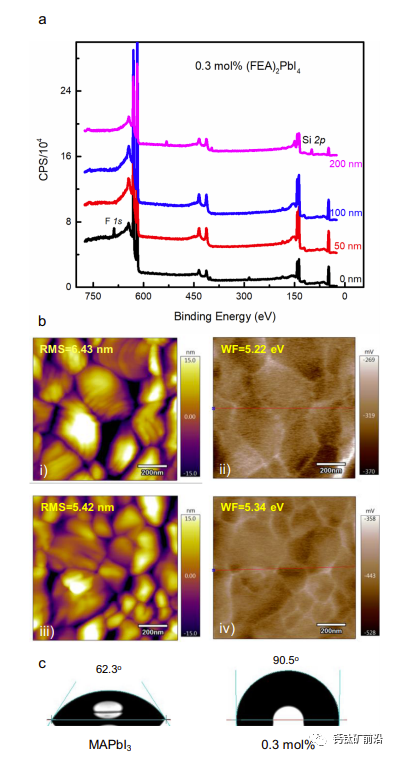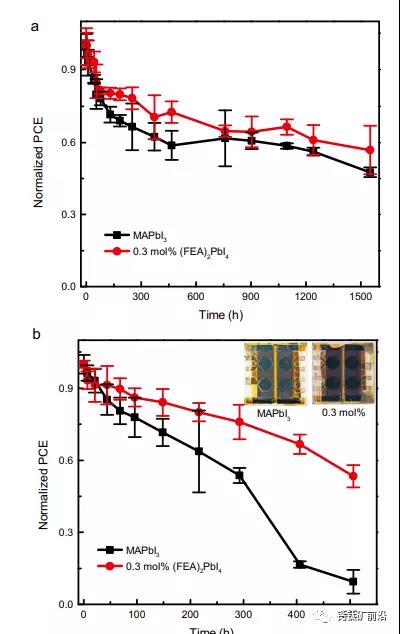
hotline:
17715390137
Tel/Wechat:
18101240246 (Technology)
0512-68565571
Email:mxenes@163.com (Sales Engineer)bkxc.bonnie@gmail.com
Scan the code to follow or search the official account on WeChat:
2D Materials Fronrier After paying attention,
click on the lower right corner to contact us,
Enter enterprise WeChat.
Professional Services Online

Introduction to Achievements
An efficient and stable perovskite solar cell with a simple active layer is required for manufacturing. Three-dimensional perovskite solar cells have the highest efficiency, but need to improve environmental stability. The inclusion of a larger ammonium salt results in a compromise between improved stability and efficiency, which is attributed to the inclusion of a two-dimensional perovskite component. Here, our work shows that adding 0.3 mol% of lead fluoride salt to the three-dimensional methylammonium lead iodide perovskite can prepare a simple inverted solar cell at low temperature, with a maximum power conversion efficiency of 21.1%. The perovskite layer has no detectable two-dimensional component at salt concentrations as high as 5 mole percent. The high concentration of fluorinated materials found at the film-air interface can provide greater hydrophobicity, the size and orientation of surface perovskite crystals increase, and unencapsulated devices have higher stability to high humidity.
Graphic introduction

Figure 1: Jsc, Voc, FF and PCE distributions of devices containing MAPbI3 and active layers with different mole% (FEA) 2PbI4. The box is defined by two lines at the 25th percentile and 75th percentile, where the line inside the box represents the median (50th percentile). The error bars indicate the 5th and 95th percentile, and the superposition of the curves indicates a normal distribution. At least eight PSCs of each type were tested. Although MAPbI3 devices have the highest short-circuit current density (Jsc) on average, the addition of a small mole% (FEA) 2PbI4 to the processing solution resulted in an increase in open circuit voltage (Voc) and fill factor (FF). ), while PCE has increased overall. Although a larger (FEA) 2PbI4 mol% in the active layer will result in a larger Voc, all other parameters and power conversion efficiency (PCE) will be reduced.

Figure 2: Photovoltaic performance of pure MAPbI3 and solar cells containing 0.3mol% (FEA) 2PbI4. a Under simulated AM 1.5 G 1 sunlight, the current density-voltage (J-V) curve of a high-performance battery measured by forward and reverse scanning (scanning rate 200 mV/s). b External quantum efficiency (EQE) spectra and integrated short-circuit current density (Jsc) of the corresponding device. c Histogram of the relationship between the number of batteries in a normal distribution and the power conversion efficiency (PCE) (at least 30 batteries for each type of device).

Figure 3: Photophysical properties of pure MAPbI3 and films containing 0.3mol% (FEA) 2PbI4. a Absorption spectrum on glass (α=absorption coefficient). b, c Temperature-dependent (K = Kelvin) photoluminescence (PL) spectra (λexc = 550 nm) on fused silica.

Figure 4: 2D GI-WAXS measurement and out-of-plane high-resolution GI-XRD pattern of the film. For pure MAPbI3 and films containing 0.3 mol% (FEA) 2PbI4, 2D GI-WAXS measurements were performed using incident beams of 0.3° and b 0.14°. The azimuthal average GI-WAXS profile of pure MAPbI3 and films containing 0.3mol% (FEA) 2PbI4 collected at the incident angles of c 0.3° and d 0.14°. e The out-of-plane high-resolution GI-XRD pattern of the film collected at an incident angle of 0.3° (note that the data has been shifted for clarity). q = momentum transfer, qz and qxy = components of the scattering vector (q) in the direction of the surface normal (z) and perpendicular to the surface normal (xy).

Figure 5: XPS, AFM, SKPM and water contact angle measurement of the film. XPS depth distribution (CPS = counts per second) on a perovskite film containing 0.3 mol% (FEA) 2PbI4. b (i) MAPbI3 and (iii) AFM of the surface of the perovskite film containing 0.3 mol% (FEA) 2PbI4 and (ii) MAPbI3 and (iv) 0.3 mol% (FEA) 2PbI4 perovskite-containing film. The function image is obtained from the SKPM measurement (RMS = root mean square roughness and WF = work function). c The contact angle measurement image of MAPbI3 and a film containing 0.3mol% (FEA) 2PbI4 on the glass/ITO/PTAA/PFN-P2 substrate.

Figure 6: Stability test of unencapsulated MAPbI3 and devices containing 0.3mol% (FEA) 2PbI4. Thermal stability test at 85°C under nitrogen atmosphere. b Perform humidity test in air with a relative humidity of 80±10% at room temperature (PCE = power conversion efficiency).
Author: Xiao Wang, Kasparas Rakstys, Kevin Jack, Hui Jin, Jonathan Lai, Hui Li, Chandana Sampath Kumara Ranasinghe, Jaber Saghaei, GuanranZhang, Paul L. Burn, Ian R. Gentle & Paul E. Shaw

| Reminder: Beijing Beike New Material Technology Co., Ltd. supplies products only for scientific research, not for humans |
| All rights reserved © 2019 beijing beike new material Technology Co., Ltd 京ICP备16054715-2号 |